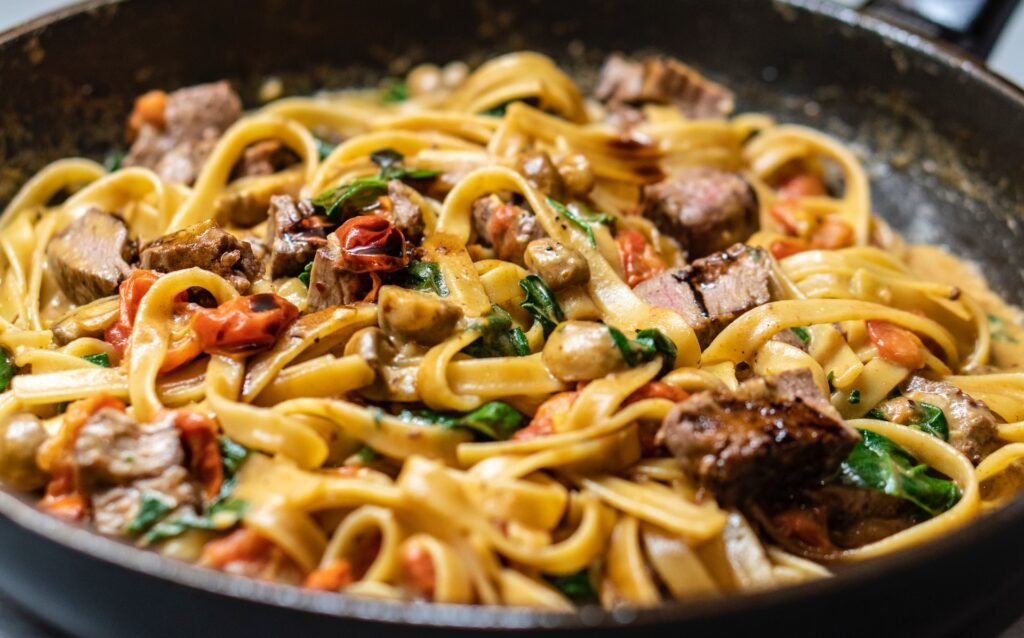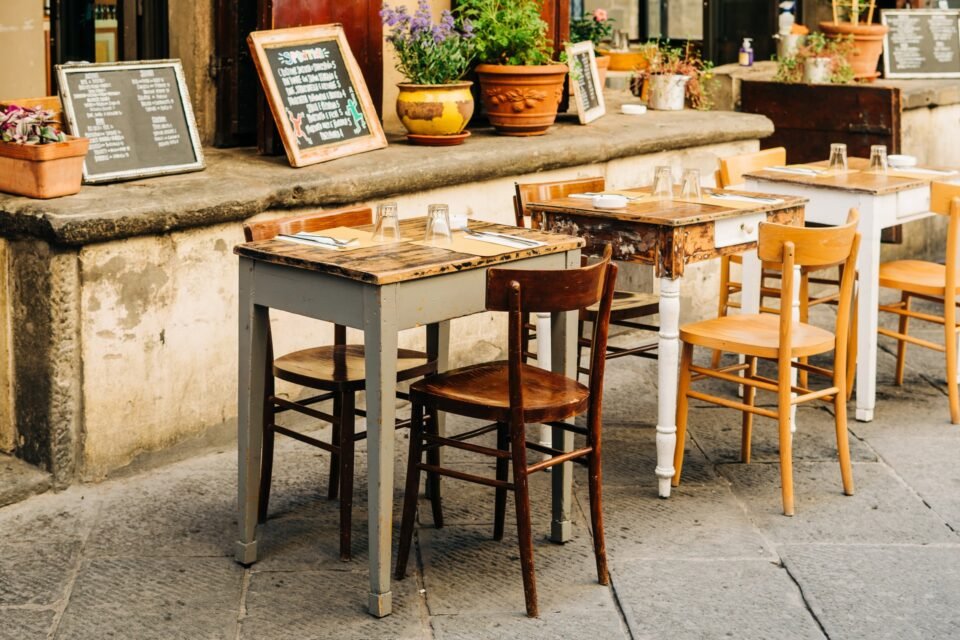The trickiest thing about eating in an Italian restaurant is that you cannot try everything. Every day you have a fixed number of meals, and a limited amount of space in your stomach, whereas there seems to be an unlimited number of Italian cuisines that you “must try.” From regional specialties to the best seasonal delicacies, you would need several lifetimes to test all the best Italian food, and that is before you even consider drinks and desserts. Before you start to panic, we have come up with a list of Italian foods that you must try when you go to an Italian restaurant next time. Taken collectively, they sum up the heart and soul of the different cooking traditions that exist around the nation. Here are a few Italian recipes, ranging from a luscious Tiramisu to Focaccia bread and much more.
Foods to Try in an Italian Restaurant
Caprese Salad with Pesto Sauce- Nothing tastes like a fresh tomato salad in summer! An antipasto bite to start your meal. This blend of juicy tomatoes and mozzarella cheese salad topped with freshly made pesto sauce is a distinct but simple one. It offers a unique twist to the classic Caprese salad.
Pizza- Though a slab of flatbread served with spices and oil was around before the unification of Italy, there is probably no dish that is as representative or as common of the country as the pizza. Cheap, easy, and filling pizza has long been a common meal or snack, mainly in Naples where tomato sauce was initially added. When Margherita, the Italian Queen came through the city on a tour of her kingdom in 1889, she wanted to try this dish after seeing many of her subjects trying this dish. A local entrepreneur served her the now-famous combination of mozzarella, tomato sauce, and basil, which led to the Margherita pizza. Whether by design or coincidence, the Margherita also reveals the colors of the Italian flag.

Today, there are majorly two types of pizza to select from in Italy. These are Roman-style pizza and Neapolitan-style pizza. Roman-style pizza has a paper-thin crust. It is large in diameter, but generally lighter and contains less gluten. Neapolitan-style pizza is a thick and fluffy crust. It tends to be a little small but is more filling.
Lasagna- This is one of the best Italian food that you must try in an Italian restaurant. It is a wide, flat pasta noodle, generally baked in layers in the oven. Like most Italian dishes, its roots are hotly disputed, but we can at least consider that its stronghold is in Emilia-Romagna, where it converted from a poor man’s food to a rich meal filled with meat or ragu sauce.
Traditionally, this Italian cuisine was not made with tomatoes; just bechamel sauce, ragu, and mozzarella cheese or Parmigiano Reggiano or a mix of the two. Even today, only a bit of tomato pieces or tomato sauce is used on a traditional ragu, unlike most of the Italian American dishes, which are swimming in tomato sauce. This concentrates the taste of the meat but at times is a little jarring for the Americans. Though you can find this Italian dish across Italy, there nothing like trying IT IN Emilia Romagna with fresh ragu, homemade noodles, and a lot of regional pride.
Pasta Carbonara- This Roman pasta dish gets its name from “Carbone” which means coal. It was a pasta popular among the coal miners. The new recipe calls from guanciale, which is the cheek of a pig, but as it is not available easily, the chef has used bacon as an alternative.
Mushroom Risotto- A plate full of Buttery Risotto with the goodness of mushrooms. A bowl of mushroom Risotto has so many benefits that you may have never imagined. A good source of protein, antioxidants, and it even contains cancer-fighting elements. This recipe with mushrooms is a tasty recipe besides being quick and easy! This is a great recipe to feed a hungry horde.
Spaghetti carbonara- Rome becomes the capital of Spaghetti. In this regard, Carbonara plays an important role, making it one of the most popular dishes in our country.
It was born casually with powdered egg yolk, bacon, cheese, milk cream, all foods with which the allies who released Italy were equipped, and for the imagination of a young cook from Bologna who gathers them as a pasta dressing in making lunch for American officers.
Over the years, the recipe has changed a little and now it includes guanciale in place of egg yolk, bacon, and cheese. With the passage of fashion, the cream vanished in favor of the taste of planning.

In a gastronomic tour of a Rome capital of pasta, the Carbonara is escorted by the mythical “Amatriciana”, initially from Amatrice on the border with Abruzzo or its antecedent, the “Gricia” or the “Cacio e Pepe” fusion of the pecorino cheese, pasta cooking water, and black pepper.
Spaghetti is not always the protagonist of these tasty dishes: Amatriciana is always proposed with “Bucatini” and “Cacio e Pepe” with “Tonnarelli.”
Pesto- From French Riviera to the Cinque Terre, basil sauce is the best gastronomic flag of the Italian Riviera. Like almost all the recipes, even popular, the origin of pesto is confused and uncertain, only towards the 19th century is there any written evidence, but certainly, the sauce is quite older.
Today, the recipe is composed of a few essential ingredients: Ligurian Basil, Vessalico garlic which is a slow food presidium, grated Parmesan Cheese, and Italian pine nuts, and Sardinian Pecorino cheese, added virgin olive oil, and coarse salt.
True pesto should not know about “heating” from the blenders or other tools of our times. The good old mortar and pestle remain to be irreplaceable to achieve the best result. Chefs from different parts of the world are using pesto in the most diverse ways, but here Pesto is the main ingredient of pasta, whether fresh.
In Genoa, you can find fresh dough preparations: Lasagne called “Mandilli de sea”, “Gnocchi”, or “Trofiette”. The recipe with dry pasta is the “trenette” which is also accompanied by diced potatoes and chopped green beans.
Fiorentina Steak- This steak covers all the characteristics of the best dishes of Italy: a certain cut of meat from a specific cow prepared in a certain wat all within the confines of a certain area.
In the case of enormous Bistecca Fiorentina, it is a T-bone steak cut thick from the lion of a Chianina cow raised in Tuscany. It is cooked for 5 to 7 minutes on each side, based on the thickness, until the outer part is cooked, and the inner part remains rare. No use in asking for a medium-well done steak, the meat is quite thick to even imagine about it!
Despite the dogma, there are a few variations on the Florentine steak. For one, the meat is not always from a Chianina cow nowadays. Many Florentines are fine with the addition of new breeds, but others swear that the immense size and muscle of the Chianina makes for the finest T-bones. If you have a doubt, just ask. Also, the Florentines tend to prefer the higher expenses, quicker to the rib cage, which consists of the fillet known as Bistecca Nella Costola, whereas beyond Florence in Tuscany you will probably get a Bistecca Nel Filetto, a smaller cut that tends to be smooth. That does not certainly mean it is better. The Florentines argue that the Bistecca Nella Costola is derived from a more used muscle, which means it is tastier.
Though this is a list of food that you must try in an Italian restaurant, make sure you eat in a reputed Italian restaurant. Among these, which is your favorite Italian cuisine? Please let us know in the comment section.

